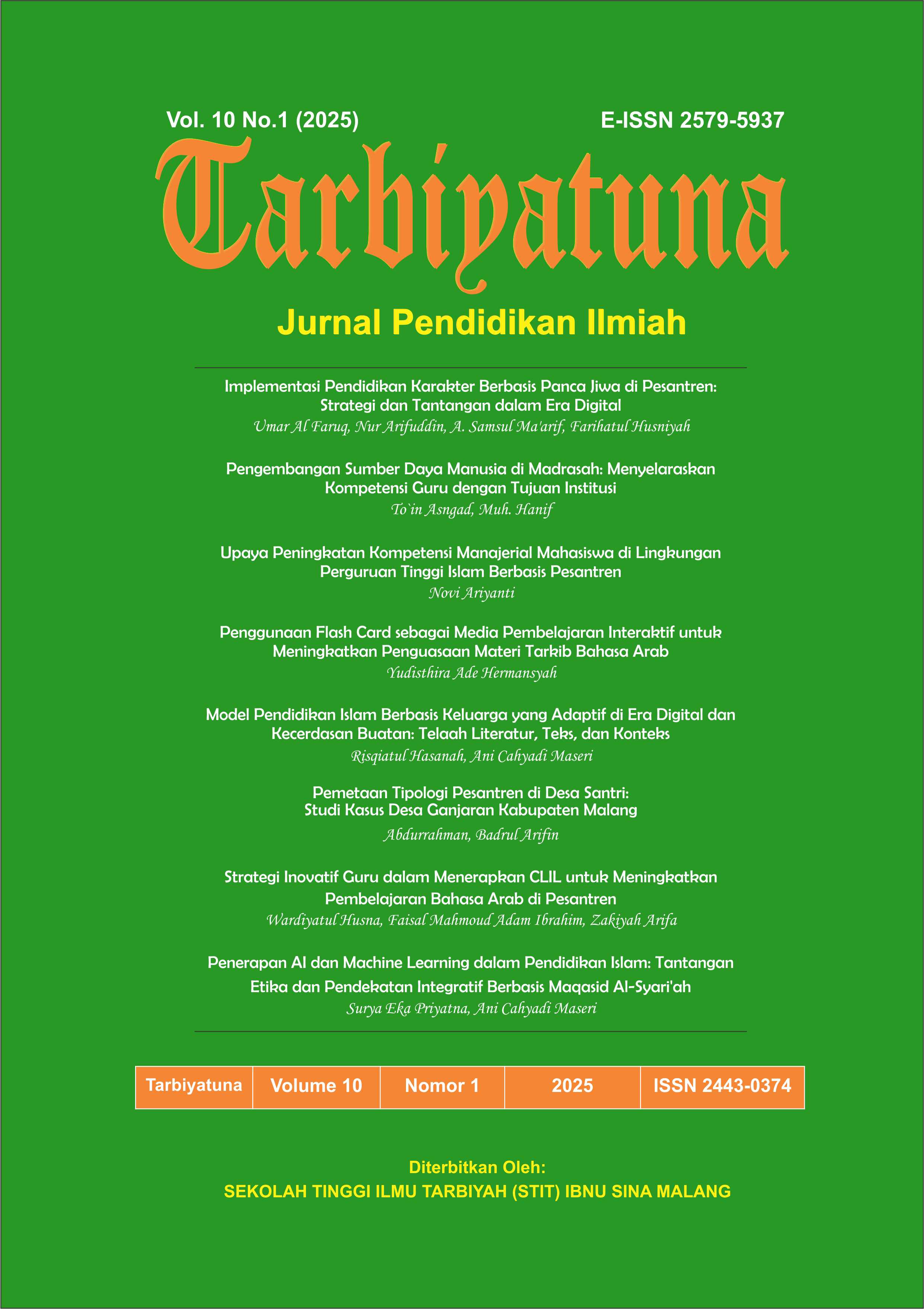Strategi Inovatif Guru dalam Menerapkan CLIL untuk Meningkatkan Pembelajaran Bahasa Arab Di Pesantren
Abstract
This study examines Arabic learning innovations through Content and Language Integrated Learning (CLIL) applied by teachers at the Darul Ukhuwah For Girl 2 Islamic Boarding School Malang. An important issue behind this research is the interest in learning Arabic which is often considered difficult and monotonous, as well as the need to increase the relevance and success of language teaching in the context of Islamic education. Therefore, this research is relevant to be discussed to explore how CLIL can be an innovative solution to overcome these challenges and achieve the goal of the boarding school in producing students who are proficient in Arabic. The research method used is a descriptive qualitative approach with data collection through in-depth interviews with teachers, classroom observations, and analysis of related documents. The purpose of this study is to comprehensively describe the teacher's experience, the learning strategies applied, and the challenges faced in the implementation of CLIL. The results showed that CLIL significantly increased teacher motivation because learning felt more meaningful and contextual. Teachers apply various strategies ranging from the preparation of an integrated syllabus, the use of varied methods, visual media, communicative approaches, scaffolding, to integrated evaluation in the classroom. However, challenges such as the heterogeneity of student understanding, difficulties in interpreting the vocabulary of interpretation, and the adaptation of teachers from outside the boarding school were also found. Overall, CLIL has been proven to be able to arouse students' interest in learning Arabic and improve their language skills naturally, supporting the achievement of Islamic boarding school educational goals.
References
Ambarwati, D., Wibowo, U. B., Arsyiadanti, H., & Susanti, S. (2021). Studi literatur: Peran inovasi pendidikan pada pembelajaran berbasis teknologi digital. Jurnal Inovasi Teknologi Pendidikan, 8(2), Article 2. https://doi.org/10.21831/jitp.v8i2.43560
Ariawan, J., Astuti, D., Harsapranata, A. I., & Ramadhayanti, A. (2022). Peran Penguasaan Bahasa Inggris Terhadap Peningkatan Kualitas Sumber Daya Manusia (SDM). Jurnal Pengabdian Mandiri, 1(2), 135–142.
Baroroh, R. U., & Tolinggi, S. O. R. (2020). Arabic learning base on a communicative approach in non-pesantren school/Pembelajaran bahasa Arab berbasis pendekatan komunikatif di madrasah non-pesantren. Ijaz Arabi Journal of Arabic Learning, 3(1). https://doi.org/10.18860/ijazarabi.v3i1.8387
Bartlett, L., & Vavrus, F. (2016). Rethinking case study research: A comparative approach. Routledge. https://www.taylorfrancis.com/books/mono/10.4324/9781315674889/rethinking-case-study-research-lesley-bartlett-frances-vavrus
Coyle, D., Hood, P., & Marsh, D. (2010a). 1 A window on CLIL. Cambridge University Press https://oxico.sk/lg/aj/assets/ukazky/clil.pdf
Coyle, D., Hood, P., & Marsh, D. (2010b). CLIL: Content and Language Integrated Learning (First). Cambridge University Press.
Karabassova, L. (2022). Teachers’ conceptualization of content and language integrated learning (CLIL): Evidence from a trilingual context. International Journal of Bilingual Education and Bilingualism, 25(3), 787–799. https://doi.org/10.1080/13670050.2018.1550048
Lai, C.-J. (2024). Examining the impact of multimodal task design on English oral communicative competence in fourth-grade content-language integrated social studies: A quasi-experimental study. Asian-Pacific Journal of Second and Foreign Language Education, 9(1), 64. https://doi.org/10.1186/s40862-024-00289-7
López-Medina, E. F., & Casado Casado, J. M. (2024). CLIL, a competence-based coping strategy against foreign language anxiety in higher education. Discover Psychology, 4(1), 68. https://doi.org/10.1007/s44202-024-00187-6
Macaraeg, J. M., Gallego, M. C., Ferrera, R. E., & Ulla, M. B. (2024). Social Sciences & Humanities Open. Journal of Social Sience and Humanities Open, 1–8. https://doi.org/10.1016/j.ssaho.2024.101165
Murtafi’ah, B., Ardini, A. S., Prasetya, W., Al Ghaniy, R. M., & Putri, D. F. (2024). Peningkatan Kompetensi English Speaking dan Komunikasi Kolaboratif Pada Siswa-Siswi MAN 3 Sleman Melalui Mayoga English Camp. ABDI MOESTOPO: Jurnal Pengabdian Pada Masyarakat, 7(1), 32–41. https://doi.org/10.32509/abdimoestopo.v7i1.3498
Nurkhin, A. (2014). Strategi Content and Language Integrated Learning (CLIL) untuk Meningkatkan Kualitas Pembelajaran Akuntansi Biaya. Dinamika Pendidikan, 9(2). https://doi.org/10.15294/dp.v9i2.4889
Nurwachidah, U. (2024). Implementasi Kurikulum Ganda Terhadap Prestasi Belajar Al-Qur’an Siswa Di SD Islam Darush Sholihin Nganjuk. At-Tajdid: Jurnal Pendidikan dan Pemikiran Islam, 8(2), 440–453. http://dx.doi.org/10.24127/att.v8i2.3488
Ozdemir, H. (2024). CLIL in Mathematics: An experiment in developing mathematical literacy in secondary education in Turkey. E-TEALS: An e-journal of Teacher Education and Applied Languages Studies, 16, 43–63.
Pramesti, A., Ritonga, A. D. J., Azkia, M. W. F., & Nasution, S. (2025). Mengungkap Faktor Penghambat dan Solusi Alternatif Pembelajaran Bahasa Arab di SMP IT Al-Hijrah Kelas IX. Al-Tarbiyah: Jurnal Ilmu Pendidikan Islam, 3(1), 209–223. https://doi.org/10.59059/al-tarbiyah.v3i1.1958
Sari, A. (2024). The practices of clil at two private primary schools: A multiple case study [PhD Thesis, Universitas Negeri Malang]. https://repository.um.ac.id/346190/
Sumartana, I. M., Subiyanto, P., & Sukra, I. N. (2024). The Development of English Language Learning Model Using Project-Based CLIL Approach to Improve Students’ English Language Competence. International Conference on Sustainable Green Tourism Applied Science-Social Applied Science 2024 (ICoSTAS-SAS 2024), 219–227. https://www.atlantis-press.com/proceedings/icostas-sas-24/126007559
Sunnatillayevna, Y. A. (2024). Adapting Clil Methodology For Higher Education In Technology Fields. Journal of Modern Educational Achievements, 11, 264–268.
Sutiyo, M. H. (2024). Peran Kompetensi Bahasa Arab Dalam Meningkatkan Pemahaman Mendalam Santri Terhadap Al-Qur’an dan Hadits. Akademika: Jurnal Manajemen Pendidikan Islam, 6(2), 280–295. https://doi.org/10.51339/akademika.v6i2.3088

